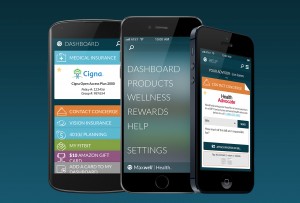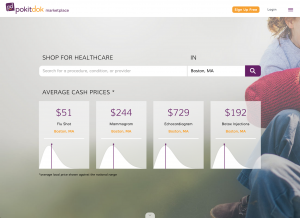“So why are you partnering with insurers and employers?” I asked the staff at Maxwell Health, who had just been regaling me with an expansive vision of consumer-centered health and transparency. Co-Founder and Chief Product Officer Vinay Gidwaney laid out a view that’s in line with everything reformers ask for: a long-range view of health care that guides people to proper health at home and not just in the clinic, giving the consumers choices along with the information to let them make good ones, etc. The kind of health system Maxwell Health aims at will be totally different from what we have now–and the current actors will have to change or vanish as it comes into being.

But of course I knew why Maxwell Health is dealing with insurers and employers. In our health care system, you must join the guild to hang your street sign. Before you can get access to the consumer, you need access to the professional organizations with whom the health consumer interacts. Individuals may download one or two of the many thousands of available health and fitness apps, but few people stick with them–or with the fitness devices that carve their behavior into eternal records in the cloud.
Although doctors complain that they can’t change people’s behavior, people are more likely to adopt technology if it is recommended by their doctor, their insurer, or even the government. Furthermore, payment models have to reward the right things, or people will continue to engage in risky behaviors and costs will continue to expand.
So Maxwell Health has found a business model on the insurance side of health care’s multi-faceted polygon. Through this they hope to reach the consumer and create change.
Another company I met at the Health 2.0 Boston hackathon, a week after talking to Maxwell Health, is making a related play in order to prosper in the health care market. PokitDok offers health care appointments on both a pay-per-visit basis and using health insurance. To this end, they have relationships with both health care providers and insurers. They can be used by any individual consumer, whereas Maxwell Health deals with people through their employers. A PokitDok API allows developers to create apps that have access to prices, providers, insurers, referrals, etc.

Let’s start with Maxwell Health. Their salient feature is “bundles” of health care options offered as benefits packages by employers, organized around a core of the insurance plans their staff can choose from. Maxwell Health can direct an employee to an appealing insurance package–for instance, one for people near retirement, another for a young couple about to have a baby. Benefits administrators create personas (hypothetical types of employee) around demographics such as age, income, and family status, then create bundles to offer to employees around these differences. Anyone who has tried to seriously compare his insurance options knows what a headache it is to figure them out. Medicare Advantage is a daunting market, and while no employer has such a large number of choices, they have enough to make the decision a nail-biter. I had trouble just choosing my tax-free flexible spending amounts each year, until the law changed this year and let employees roll unspent money forward. Maxwell Health hopes to turn benefit choices into an experience as appealing, well-integrated, easy as a good online retail shop.
While choosing an insurance plan, employees are prompted also to sign up for services that may help them with their health needs: fitness devices, coaching services, emergency day care, meal delivery services, etc. Bundles also contain services that benefits coordinators think would interest employees with a given persona.
The customer can also load apps from Maxwell Health that help them find services. For instance, they have a contract with Doctor on Demand, a popular telemedicine site. (This one-time telemedicine service is a convenience, not a replacement for developing a relationship with a provider who has a broad knowledge of the consumer and family.) Another service lets employees can take a picture of a confusing medical bill and contact an expert to explain and even change the bill.
On the back end, Maxwell Health provides typical web-based services to benefits administrators, making it easier for them to carry out their routine tasks such as determining participation in plans by employees and tracking the use of services. As PR and marketing associate Meg Murphy says, benefits administrators “can throw away their fax machine.”
The company’s solution requires a lot of work at each employer, but the insurance broker is well positioned to work with each employer to represent the benefits correctly, suggest new benefits, and serve up the benefits through the Web and mobile devices. In addition to its close work with insurers, Maxwell Health also lets fitness devices stream data to a Maxwell Health mobile app. This app has three overall parts: a virtual insurance ID card for every insurance plan in which the employee is enrolled, a wellness program with connections to fitness devices and rewards, and a healthcare concierge who handle requests like the confusing bill already mentioned.
Now for PokitDok. The simplest part of their offering is an app helping consumers find doctors for individual fee-for-service procedures. A consumer can search for the medical procedure he needs and book an appointment through the service. PokitDok determines fees through a rather labor-intensive process (calling the doctors) as well as by checking actual prices paid in the past. The web site guides the user by showing a range of possible insurance costs (low, median, and high).
Once the user chooses a provider and books a procedure, PokitDok charges the posted fee and collects the money online. Hence, the welter of health care costs is managed by simply making each provider advertise his fee (already quite a break from the standard health market in the US.) PokitDok therefore includes a degree of transparency for its providers that Clear Health Costs provides through crowdsourcing for a wide range of popular tests and procedures.
But PokitDok also allows patients to pay through insurance. This is a much steeper challenge. Insurance reimbursements vary from doctor to doctor, plan to plan, and employer to employer. Nor do most of the actors in this masquerade want to reveal their prices and the yawning ranges they span. So PokitDok, once again, checks prices paid in the past to estimate the low, median, and high cost for insurance coverage. The user can also specify one or more insurers when searching for a procedure.
It’s interesting that John Riney, coder and technical evangelist at PokitDok, described their essential goal in terms very similar to those used by Maxwell Health representatives: let’s turn the search for health care into a consumer experience as simple and satisfying as good retail shopping.
Right now, the main actors in the health care space maintain silos. The new players like Maxwell Health and PokitDok feel the way most of us in the health movement feel: they would prefer an open ecosystem where the parts work together and anybody can sign up to play. Piggybacking on a complex payment system set up decades ago may be the necessary focal point on which new companies can press the lever of change.













